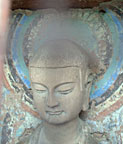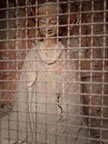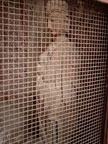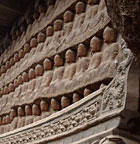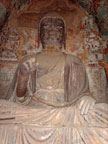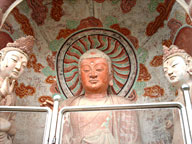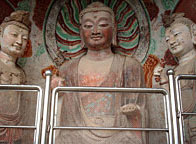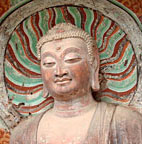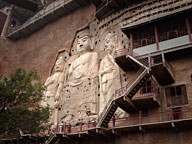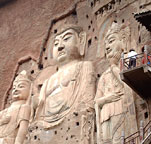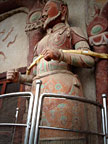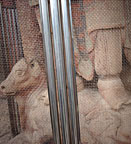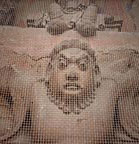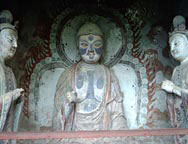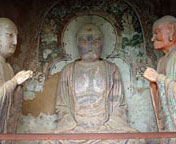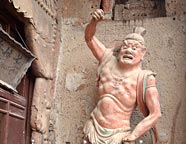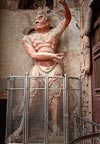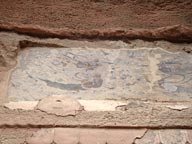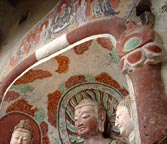Notes and References:
1. Qin dynasty ruled
in China between 221-207 B.C.
2. Fu Xiaofan and
Du Mingfu, Dongfang Weixiao (Oriental Smile), Dunhuang Art and
Culture Publishing house, Lanzhou, 2003, p.32.
3. Takayasu Higuchi
and Gina Barnes, “Bamiyan: Buddhist Cave Temples in Afganistan”,
World Archaeology, Vol.27, No.2, Buddhist Archaeology, Oct.1995,
p.283.
4. Dou Hongtao,
“Zhongguo Si Da Shiku”(The Four Big Rock-cut Caves of China),
Sheke Zongheng Wenshi Yanjiu (Zongheng Society Culture and History
research), Vol.5, 2001, p.43.
5. Radha Banerjee,
“Indian Inputs to Chinese Art”, Dialouge(A quarterly Journal
of Asha Bharati), Vol. 5, January-March 2004 (http://www.asthabharati.org/Dia_Jan.04/Indian%20inputs-Banerji.htm)
6. Including Sui (581—618
A.D.), Tang (618-907 A.D.), Five dynasties (907—960 A.D.), Song (960—1279
A.D.), Yuan (1271—1368 A.D.), Ming (1368—1644 A.D.) and Qing
(1644—1911 A.D.)
7. Wei Wenbin, “Maijishan
Shi Ku Jige Wenti de Sikao he Renshi (Several considerations on the study
of Maiji Mountain Grottoes)”, Dunhuang studies, 2003, No.
6, pp.15-22.
8. Tang Chung, ed.
and trans., Dunhuang Art through the Eyes of Duan Wenjie, Indira
Gandhi National Centre for the Arts, New Delhi, India, 1994, p.22
9. Cai Min, Fojiao
Shiku Kaogu Gaiyao (An outline of Buddhist Rock-cut Archaeology),
Cultural Relics Publishing House, Beijing, 1993, p.79.
10. Mitch Mudra,
“Diminutive Mountain with a Gargantuan Impact”, (http://www.stolaf.edu/courses/2004sem1/Art_and_Art_History/259/mudram/Maijishan_files/MaijishanEssay.htmA)
11. Fu Xiaofan,
“Duju Tese De Maijishan Shiku” (The Unique Maiji Mount Grottoes),
Journal of Tianshui Normal University, Tianshui, China, Vol.24,
No.4, 2004, p.72.
12. Dong Anqiang,
Juebi Shang De Foguo (Rock-cut Buddhist area), Maijishan Shiku
Yishu Daolan (Guide book of Maijishan grotto art), n.p., n.d., p.32.
13. Xia Lanyun,
“Maijishan Zaoqi Da Kan Xiaceng Fenshao Henji De Kaocha- Maijishan
Hou Qin Kai Ku Xin Zheng (An Investigation of the burning traces in the
lower level of early big niches of Maijishan- new evidence regarding Later
Qin construction at Maijishan)”, Dunhuang Research, No.
6, 2004, p.33.
14.
see the cave nos. 16, 23, 69, 70,
71, 75, 76, 80, 83, 85, 87, 90, 93, 100, 101, 112, 114, 115, 120, 121,
122, 128, 133, 138, 139, 140, 142, 143, 144, 148, 154, 155, 156, 159,
163 and 169. Tianshui
Maijishan, (The Maijishan Grottoes at Tianshui), Zhongguo Shiku(The Grotto
Art of China), Compiled and edited by Art research Institute of the
Tianshui Maijishan, Cultural Relics Publishing House, Beijing, 1998, pp.
275-292.
15. Sun Jiyuan,
“Maijishan Diaosu Yishu De Chengjiu (The fruit of Maijishan stucco
and sculpture works)” in Tianshui Maijishan, (The Maijishan
Grottoes at Tianshui), Zhongguo Shiku(The Grotto Art of China), op. cit.,
p.182.
16. ibid,
p. 283.
17. see also the
caves 20, 43, 44, 88, 92, 102,105, 110, 120, 123, 127, 135, 146, , 161,
162 and 172. ibid, p. 277-291.
18. Radha Banerjee,
op. cit.
19. Chen Yuexin,
“ Xi Wei Bei Zhou Shiqi De Maijishan Siku (Maijishan Caves of Western
Wei and Northern Zhou period)”, Central Plain Cultural Relics
No.4, 2006, p.61
20. Tianshui
Maijishan, (The Maijishan Grottoes at Tianshui), Zhongguo Shiku(The Grotto
Art of China), op. cit. , pp.274-291.
21. ibid,
p.243.
22. ibid,
pp.275-76; 278; 281.
23. ibid,
p.276.
24. Fu Xiaofan and
Du Mingfu, op.cit., p.170.
25. Dong Anqiang,
op.cit., pp.128-129.
26. Zhang Baoxi,
“Maijishan Shiku Bihua Xuyao (A consice introduction of the Maijishan
murals)”, in Tianshui Maijishan, (The Maijishan Grottoes at
Tianshui), Zhongguo Shiku(The Grotto Art of China), op.cit. , pp.190-192.
27. ibid,
p.198.
28. ibid.
|






